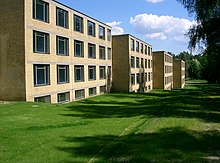Hannes Meyer
Hans Emil "Hannes" Meyer (18 November 1889 – 19 July 1954) was a Swiss architect and second director of the Bauhaus Dessau from 1928 to 1930.
In 1923, Meyer co-initiated the architectural magazine 'ABC Beiträge zum Bauen' (Contributions on Building) with Hans Schmidt, Mart Stam, and the Suprematist El Lissitzky in Zurich.
[4] His philosophy was that architecture was an organizational task without relationship to aesthetics, that buildings should be low cost and designed to fulfill social needs.
[6] The other major building commission was the Bundesschule des Allgemeinen Deutschen Gewerkschaftsbundes (ADGB Trade Union School), in Bernau bei Berlin, which was completed during 1930.
[11] Meyer continued with Gropius' innovations to emphasize designing prototypes for serial mass production and functionalist architecture.
In the increasingly dangerous political era of the Weimar Republic, Dessau's Mayor, Hesse, alleged that Meyer allowed a Communist student organization to flourish and bring bad publicity to the school, threatening its survival.
[13] In the autumn of 1930, Meyer emigrated to the Soviet Union, along with several former Bauhaus students, including Konrad Püschel and Philipp Tolziner [de].
The son Johannes Mengel, born 4 January 1927, survived in a state reformatory and only learned of his mother's violent death in 1993.
In 1939 Meyer emigrated to Mexico City to work for the Mexican government as the director of the Instituto del Urbanismo y Planificación from 1939 through 1941.

